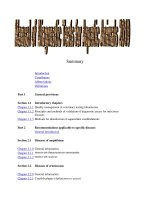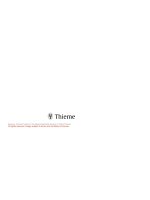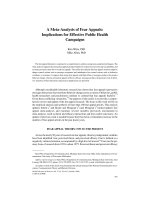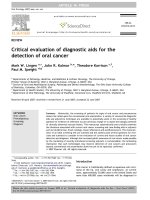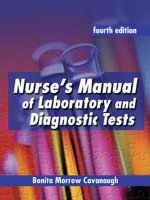Cost-effectiveness analysis comparing companion diagnostic tests for EGFR, ALK, and ROS1 versus next-generation sequencing (NGS) in advanced adenocarcinoma lung cancer patients
Bạn đang xem bản rút gọn của tài liệu. Xem và tải ngay bản đầy đủ của tài liệu tại đây (757.12 KB, 10 trang )
Schluckebier et al. BMC Cancer
(2020) 20:875
/>
RESEARCH ARTICLE
Open Access
Cost-effectiveness analysis comparing
companion diagnostic tests for EGFR, ALK,
and ROS1 versus next-generation
sequencing (NGS) in advanced
adenocarcinoma lung cancer patients
Luciene Schluckebier1, Rosangela Caetano2, Osvaldo Ulises Garay3,4, Giuliana T. Montenegro5, Marcelo Custodio5,
Veronica Aran1,6* and Carlos Gil Ferreira1,7
Abstract
Background: The treatment of choice for advanced non–small cell lung cancer is selected according to the
presence of specific alterations. Patients should undergo molecular testing for relevant modifications and the
mutational status of EGFR and translocation of ALK and ROS1 are commonly tested to offer the best intervention. In
addition, the tests costs should also be taken in consideration. Therefore, this work was performed in order to
evaluate the cost-effectiveness of a unique exam using NGS (next generation sequencing) versus other routinely
used tests which involve RT-PCR and FISH.
Methods: The target population was NSCLC, adenocarcinoma, and candidates to first-line therapy. Two strategies
were undertaken, strategy 1 corresponded to sequential tests with EGFR RT-PCR, then FISH for ALK and ROS1.
Strategy 2 differed from 1 in that ALK and ROS1 translocation testing were performed simultaneously by FISH.
Strategy 3 considered single test next-generation sequencing, a platform that includes EGFR, ALK and ROS1 genes.
A decision tree analysis was used to model genetic testing options. From the test results, a microsimulation model
was nested to estimate survival outcomes and costs of therapeutic options.
Results: The use of NGS added 24% extra true cases as well as extra costs attributed to the molecular testing. The
ICER comparing NGS with sequential tests was US$ 3479.11/correct case detected. The NGS improved a slight gain
in life years and QALYs.
Conclusion: Our results indicated that, although precise, the molecular diagnosis by NGS of patients with advanced
stage NSCLC adenocarcinoma histology was not cost-effective in terms of quality-adjusted life years from the
perspective of the Brazilian supplementary health system.
Keywords: Lung cancer, NGS, NSCLC, Diagnostic methods, Health economics, EGFR, ALK, ROS1
* Correspondence:
1
Fundação do Câncer, 212 - Centro, Rio de janeiro 20231-048, Brazil
6
Instituto Estadual do Cérebro Paulo Niemeyer, R. do Rezende, 156 - Centro,
Rio de Janeiro 20231-092, Brazil
Full list of author information is available at the end of the article
© The Author(s). 2020 Open Access This article is licensed under a Creative Commons Attribution 4.0 International License,
which permits use, sharing, adaptation, distribution and reproduction in any medium or format, as long as you give
appropriate credit to the original author(s) and the source, provide a link to the Creative Commons licence, and indicate if
changes were made. The images or other third party material in this article are included in the article's Creative Commons
licence, unless indicated otherwise in a credit line to the material. If material is not included in the article's Creative Commons
licence and your intended use is not permitted by statutory regulation or exceeds the permitted use, you will need to obtain
permission directly from the copyright holder. To view a copy of this licence, visit />The Creative Commons Public Domain Dedication waiver ( applies to the
data made available in this article, unless otherwise stated in a credit line to the data.
Schluckebier et al. BMC Cancer
(2020) 20:875
Background
Advanced lung cancer has played a key role in the development of medicines aimed for individualized therapy.
Currently, it is recommended that all patients who are
candidates for chemotherapy treatment should undergo
molecular testing to determine the best treatment clinically available [1–3].
The Epidermal Growth Factor Receptor (EGFR) was
the first antigenic target used as a guideline for targeted
lung cancer therapy, followed by other targeting
markers, such as KRAS (Kirsten rat sarcoma viral oncogene homolog) and fusion of EML4-ALK1 (echinoderm
microtubule-associated protein-like 4 – anaplastic
lymphoma kinase), along with other ongoing clinical trials, such as MET, BRAF, RET (Echinoderm Microtubule
Associated Protein like 4-AL-Kinase 1) and ROS1 (receptor tyrosine kinase 1) [4]. These genes are frequently mutated in non-small cell lung cancer (NSCLC) with
variable frequencies: EGFR [5, 6], ALK [7]; ROS1 [8, 9]
and RET [10]. The majority of these mutations are mutually exclusive, and sensitive to targeted therapies available at the clinic level.
Different mutations can be identified through different
genotyping methods that cover “screening” or “targeting”
[11]. Also, methods may vary depending on the type of
material available for examination, coverage of mutations, performance, accuracy, technical complexity and
costs [12]. Making a poor choice of test can, aside from
wasting tissue samples, compromise the entire treatment. This might occur since less accurate tests might
lead to inadequate results, ineffective therapy, and lost
time and resources.
Technologies such as sequencing, PCR, in situ
hybridization (FISH) and immunohistochemistry (IHC),
among others, were developed and are being used for
the clinical evaluation of oncogenic markers. Due to
technical limitations and the small amount of material
obtained from biopsies, none of these techniques can be
scaled to meet the increasing number and variety of genomic changes. This has led to the development of parallel multi-genic DNA sequencing platforms such as nextgeneration sequencing (NGS), that allows for the simultaneous analysis of hundreds of genetic alterations in a
single test [13].
The major impediment for effective implementation of
individualized therapy is the access to companion tests
and drugs, due to the high costs that health systems generally cannot afford. Brazil is a middle-income country
that had an estimated 208 million inhabitants and where
31,270 new lung cancer cases were expected in 2018
[14]. Within the country, two health subsystems coexist,
one of public and universal financing and the private
health insurance sector covering around 47 m people
(about 25% of the population) [15]. The regulation
Page 2 of 10
defines the compulsory coverage of private health care
plans throughout the national territory for oral antineoplastic treatments, ensuring access to treatment with
gefitinib, erlotinib, afatinib and crizotinib [16]. The Law
also comprises companion tests without defining which
method should be used. The 3rd generation EGFR inhibitors (e.g. osimertinib) and the 2nd and 3rd generation
ALK inhibitors (e.g. alectinib, ceritinib, brigatinib, lorlatinib) were not included in this model, neither as options
for first-line therapy nor at the time of progression on
first-line inhibitors, since these options were not
registred in Brazil at the time, and they did not have any
payment or reimbursement support in our country.
The NGS technique has been raising expectations
about the possibility of performing a single test to define
prognosis and treatment. However, this technique is associated with high costs, raising doubts about whether
its dissemination is cost-effectiveness for health systems.
Few countries evaluated the varying strategies for the
use of molecular tests [17, 18]. To this end, this work
compared, in terms of cost and effectiveness, the inclusion of varying companion diagnostic tests in a single
test-treatment model. The tests included recommended
techniques currently used in clinical practice for identifying mutations in EGFR (e.g. RT-PCR), and ALK and
ROS1 (e.g. FISH), to the single test using NGS for tumor
tissue samples. All analyses were done from the perspective of the Brazilian private health insurance sector.
Methods
Study population and treatment strategies
A cost-effectiveness study was done in reference to the
population of adult patients affected with adenocarcinoma of NSCLC stage IV. The economic analysis considered the long-term effects of technical performance and
the accuracy of the following molecular testing strategies
used for tumor tissue biopsies:
Strategy 1: RT-PCR for mutation identification of the
EGFR gene. If negative, the individual is sent for ALK
gene fusion testing; should this test also be negative, the
patient continues on to ROS1 gene testing. Strategy 2:
differs from strategy 1 in that ALK and ROS1 translocation testing are performed simultaneously by FISH.
Strategy 3: considers new intervention along with nextgeneration sequencing, with a platform that includes
EGFR, ALK and ROS1 genes in a single test.
A decision tree model was built comparing the three
strategies based on prevalence of genetic alterations, accuracy, and tests performance (Fig. 1).
The transition state models were constructed based on
different available information. Positive results for EGFR
led to the use of gefitinib in the first line [19, 20]
followed by conventional chemotherapy with pemetrexed plus cisplatin after the first progression [20, 21]
Schluckebier et al. BMC Cancer
(2020) 20:875
Page 3 of 10
Fig. 1 Decision tree model comparing companion diagnostics in sequence versus NGS. Legend: NSCLC: non-small cell lung cancer; pT+:
proportion of positive tests (TP + FP); pT-: proportion of negative results (TN + FN); pTP: true positive probability; pFP: false positive probability;
pTN: true negative probability; pFN: false negative probability. Note: pTP = prevalence x sensitivity x (1-unknow); pFP = (1-prevalence) x (1specificity) x (1-unknow); pTN = (1-prevalence) x specificity x (1-unknow); pFN = prevalence x (1-sensitivity) x (1-unknow)
and docetaxel after the second [22]. Positive diagnosis
for ALK or ROS1 translocation results in the use of crizotinib in the first line [23]. After progression, the treatment regimens were as described previously. The
possibility of repeating the tissue biopsy was not considered for inconclusive cases. If the tests were negative or
inconclusive, treatment began with pemetrexed plus
platinum in the first line [24, 25], docetaxel following
progression and gemcitabine in the third line [25]. Because of the specificity of the isolated test for EGFR, individuals with false-positive EGFR results entered the
simulation using TKI therapy, but with survival attributed to those with negative EGFR profile [26].
Relevant outcomes estimated in the study were the
costs associated with molecular diagnosis and treatment, correctly diagnosed cases (true positive and
true negative) from the different diagnostic strategies,
years of life gained and quality-adjusted life year
(QALY). The time horizon is 5 years and all costs and
health outcomes were discounted at an annually rate
of 5% according to Brazilian health economic evaluation guidelines [27].
The parameters utilized in the model, as well as the value
limits used in the sensitivity analysis, are described in Table 1.
For the parameters of accuracy of the tests, literature comparing Cobas® EGFR Mutation Test (Roche), Therascreen
EGFR PCR kit (Qiagen) and NGS with traditional direct sequencing from Sanger were used. The costs associated with
the tests were based on the prices in the Brazilian market,
and the benchmark value for payment from the Brazilian private sector (CBHPM). Treatment values were calculated
using standard chemotherapy and target therapy protocols,
with costs of medicines obtained from the price list released
by the National Health Surveillance Agency (CMED/
ANVISA) and corresponding to the month of March/2017.
Additional costs associated with pre-chemotherapy (average
US$ 250.00 per cycle) and room rates (US$ 33.00 per cycle)
were also considered in parenteral drugs. All costs were calculated in local currency and converted to US dollars using
the purchasing power parity conversion factor. The values of
utilities were estimated based on responses and toxicities associated with treatment [37, 38].
The incremental cost-effectiveness ratio (ICER) was calculated using the ratio of the differences between costs
Schluckebier et al. BMC Cancer
(2020) 20:875
Page 4 of 10
Table 1 Summary of parameters, range and parameter distribution used in sensitivity analysis
Parameters
Reference
case
Minimal
value
Maximal
value
Distribution
References
Genetic alterations
Prevalence EGFR
0.28
0.22
0.34
Beta
[28, 29]
Prevalence Alk
0.05
0.02
0.07
Beta
[7, 28]
Prevalence Ros1
0.02
0.01
0.03
Beta
[8, 30]
Test accuracy
Sensitivity EGFR
0.98
0.95
0.99
Beta
[12, 31–33]
Specificity EGFR
0.89
0.69
1.00
Beta
[12, 31–33]
Sensitivity Alk
1.00
0.75
1.00
Beta
[34]
Specificity Alk
1.00
1.00
1.00
Beta
[34]
Sensitivity Ros1
1.00
0.75
1.00
Beta
Assumption, as reference test
Specificity Ros1
1.00
1.00
1.00
Beta
Assumption, as reference test
Sensitivity NGS
0.99
0.96
1.00
Beta
[35, 36]
Specificity NGS
1.00
0.82
1.00
Beta
[35, 36]
pUnknow EGFR
0.13
0.06
0.34
Beta
[12, 31–33]
pUnknow FISH (ALK e ROS)
0.10
0.02
0.38
Beta
[37, 38]
pUnknow NGS
0.04
0.00
0.09
Beta
[39–41]
cEGFR
428.14
363.57
477.39
Gama
cFISH Alk
573.70
423.11
753.77
Gama
AMB, CBHPM - 2016; ANS,D-TISS; search
from current Brazilian market price
cFISH Ros1
564.99
423.11
753.77
Gama
cNGS
1874.37
1502.51
2110.55
Gama
Cisplatin 50 mg
113.57
63.11
141.95
Gama
Crizotinib 250 mg
15,084.79
11,245.02
19,298.94
Gama
Docetaxel 80 mg
1271.57
1463.21
1589.47
Gama
Gefitinib 250 mg
2256.31
1631.86
2820.38
Gama
Test performance
Test costs
Drug price
Gencitabin 1000 mg
1881.43
799.77
2351.78
Gama
Pemetrexed 500 mg
3418.88
2484.86
4273.60
Gama
0.65
0.60
0.71
Beta
Anvisa, Câmara de Regulação do
Mercado de Medicamentos - CMED
Utilities
1st line with Gefitinib (M1)
[37, 38]
1st line with Crizotinib (M2)
0.66
0.60
0.71
Beta
[37, 38]
Pemetrexed + cisplatin (M3, 1st Progression
in M1 & M2)
0.62
0.56
0.67
Beta
[37, 38]
2nd or 3rd line with standard chemotherapy
(2nd Progression in M1, M2, M3 and 1st
Progression in M3)
0.57
0.51
0.64
Beta
[37, 38]
0.05
0.00
0.10
Beta
[27]
Others
Discount rate
and QALYs among strategies. The ICER represents the incremental cost of a strategy for gaining a single unit of
health benefit. To assess the degree of uncertainty of the
results, the probabilistic sensitivity analysis was performed
by varying all parameters within the uncertainty interval,
according to their distribution (Table 1).
Results
Decision tree model comparing three molecular testing
strategies
A decision tree model was constructed comparing the
three strategies (described in the methods section) based
on prevalence of genetic alterations, accuracy, and
Schluckebier et al. BMC Cancer
(2020) 20:875
performance of the tests (Fig. 1). Our analysis show that
the NGS strategy was not cost-effective compared to the
others, however it displayed a higher probability of correct diagnoses (sum of true positive and negative cases)
with 96.3% when compared to 72.6% for strategy 2 and
68% for strategy 1. The decision analysis model also
showed that, hypothetically, performing 1000 NGS tests
would yield 270 true EGFR positive cases, 50 positive
cases for ALK and 15 positive cases for ROS1. On the
other hand, 1000 tests using strategy 2 for EGFR mutation plus 500 FISH tests, would yield 240 true positive
EGFR cases, 25 positive cases for ALK and 8 positive
cases for ROS1. Regarding performance status, NGS resulted in 34 inconclusive tests, and strategy 2 with EGFR
mutation kit resulted in 130 inconclusive cases, plus 55
inconclusive cases for FISH.
State transition model of treatment options according to
molecular test results
From the tree model results, a microsimulation model was
designed to estimate the effectiveness of the diagnostics
up through treatment, based on free survival data, progression, and overall survival rates of the different therapies. The study modelled the complete course of treatment
over the entire life expectancy of the patients through a
microsimulation model, which included second and third
treatment lines. The clinical practices regarding the treatment lines used were selected from the therapeutic guidelines and validated based on consultation with specialists
working in the Brazilian private health insurance sector to
reflect the practice in the country.
Three transition state models were constructed, corresponding to disease progression and treatment until the
third line (Fig. 2).
Page 5 of 10
Analysis of incremental cost, effectiveness in terms of
correct case detected and the incremental costeffectiveness ratio
The use of NGS identified an additional benefit of 24%
of correctly diagnosed cases at an incremental cost of
$800.76. The ICER comparing NGS with sequential tests
was US$ 3479.11 for each correct case detected. The
comparison of strategies 2 and 1 (2:1), indicated that the
ICER was US$ 961.46 for each correct case detected
(Table 2).
The impact of the choice of diagnostic strategy on
survival
The first part of the decision analysis model considered
only the intermediate effects, which are the test results.
To identify if, apart from the test results, the choice of
diagnostic strategy has an impact on survival, a transition state model was used to consider the effectiveness
of treatment. Regarding survival, the difference in incremental years of life gained, and QALYs between the
strategies was very small. The cost-effectiveness plan in
Fig. 3 indicates, at each point, the results of the microsimulation in terms of the incremental effectiveness and
incremental cost. The calculated values for the incremental cost-effectiveness ratio from the simulations are
around US $ 214,000.00 per QALY gained (IC95%: US$
166,566.38 – 279,245.48).
NGS compared to standard strategies
Cost-effectiveness acceptability curves were constructed
to show the probability of each strategy being considered
as cost-effective in relation to another, using values that
health plans could afford to pay per QALY (Fig. 4). Our
results show that the probability of the NGS test being
Fig. 2 State transition model of therapeutic options according to molecular test results. Notes: These transition models were linked to each
decision tree branch. Each arrow indicates the possible transitions for each state. Legend: PD: progression disease; w: week
